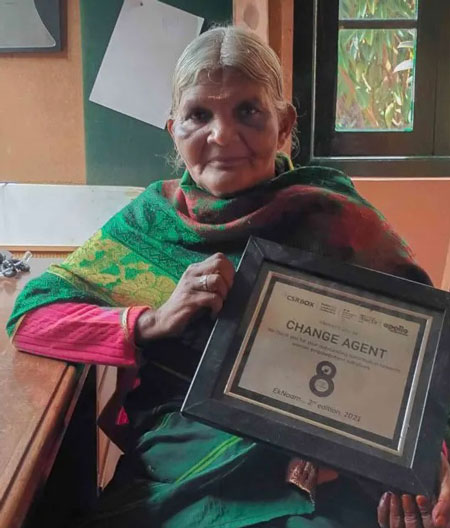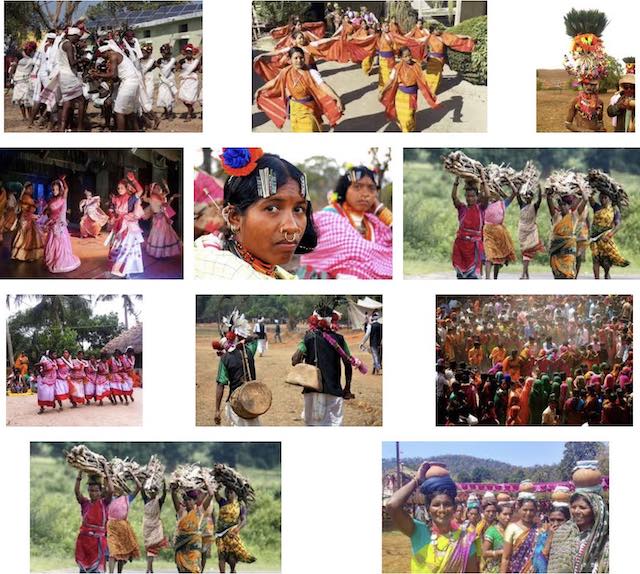At a time when most art forms of the Scheduled Tribes in the country have faded into oblivion, the Kerala Institute for Research, Training and Development Studies of Scheduled Castes and Tribes (KIRTADS) in Kozhikode is on a mission to revive and reacquaint them to the new generation of the respective tribes.
‘Kol attai, Thotti Attai, Sododimi…’ held in Kozhikode on Tuesday was an endeavour towards this end. The programme was the culmination of a 15-day training programme for youngsters from the Kattunaikka tribe in Wayanad with an aim to reacquaint them with their own dance forms. Twenty-five members of the tribe, including five trainers, took part in the training camp held on KIRTADS campus in Chevayur from December 1 to 15. The participants of the camp got an opportunity to present what they learnt on stage before an audience on Tuesday. […]
Camps were held to revive endangered art forms such as Koraganrutham, Ooralikoothu and Paniyanrutham in the previous years. This year, it was the turn of Kolkkali, Vattakkaliand a special dance form performed to celebrate a girl entering puberty, traditional to the Kattunaikka community. […]
Noted folklorist and exponent of indigenous knowledge Raghavan Payyanad inaugurated the programme while senior administrative officer of KIRTADS T.K. Radhakrishnan presided. […]
“They have lost their livelihood, their forests and even their Gods. Now they will also lose their language,” he said and urged the governments to let them keep their culture.
Source: “Relinking tribal youth with their culture”, The Hindu (Kozhikode), 16 December 2015
Address: https://www.thehindu.com/news/cities/kozhikode/relinking-tribal-youth-with-their-culture/article7994424.ece
Date Visited: Wed Jan 06 2016 14:36:27 GMT+0100 (CET)
Eco-feminism drive wins accolades
Rajasthan panchayat takes up initiative to save girl childSocial evils such as female foeticide, witch branding and sex discrimination are still to fade away from the male-dominant rural society of Rajasthan. But, a village in this desert state has set a new precedent by shedding such taboos. Piplantri village panchayat of Rajasmand district has been saving girl children and simultaneously increasing green cover by their unique initiative of “eco-feminism”.
To mark the birth of a girl child in the panchayat, the family along with villagers celebrates the occasion by planting 111 saplings of neem, sheesham, mango and amla and the community ensures they survive as the girl grows up. Community even collects donation and puts Rs 31,000 in a 20-year fixed deposit scheme in a local bank to share the burden of parents and ensure the timely marriage of the girl.
Piplantri panchayat has a population of 8,000 and villagers religiously follow rules introduced by their former sarpanch Shyam Sundar Paliwal, almost a decade back. Paliwal is proud of the measures he took as the sarpanch. Around 60 girl children are born every year in the village. […]
Initially, more than 50 per cent of the families in the village refused to accept the new model of “eco-feminism” introduced by Paliwal. Later, the panchayat members introduced the fixed deposit scheme to share the financial burden of the parents while marrying their daughters. The initiative, at many places, was linked to old religious customs where parents were educated about the importance of daughters and trees.
A special committee was also constituted to encourage and monitor the new initiative. The committee comprised villagers, a few former and present members of the panchayat, the village school principal and anganwadi members. […]
“In many villages in Rajasthan, a girl child is looked upon as a curse because her father has to give dowry at the time of her marriage. And they prefer a son as he helps father in earning his daily bread for the family. This was the reason we started making fixed deposit in the name of girl child in the village,” said Paliwal. “We tried to share financial burden of the parents and the idea clicked. The government should ideally work on similar model,” he added.
On their birthday, every girl along with other girls and women offer prayers to the trees. To prevent termite attack, residents have planted lakhs of Aloevera saplings around them. Now, they have become a major source of livelihood for many locals who market aloevera products like juice, gel and pickle.
Piplantri has turned almost into an oasis and it is surrounded by a large number of trees. “My daughter is seven years now. I have seen these trees and my daughter grow up together. Initially, not all villagers agreed to follow the idea of planting 111 saplings. Now, it’s no less than any ritual in our village,” said Shantu Bhil, a tribal from Piplantri village.
Another resident of Piplantri village said that it was for the first time he decided to bring up his daughter just like a son. Despite being a school teacher he never sent his daughter to a school. […]Paliwal is now running a campaign against alcohol consumption and cutting trees. He claims to have done significantly well, which is evident from the fact that no police case has been registered in Piplantri panchayat in the last 3-4 years. At a time when state governments are spending huge amounts and campaigning hard to save girl children, the innovative model of Piplantri had a multi-dimensional impact on the social and economic life of its residents. […]
As a result, the enrolment of girls has increased tremendously. All girls are given free uniform and books by the funds collected by the villagers.
Source: “Eco-feminism drive wins accolades” by Abhishek Gaur, Deccan Herald, 5 April 2015
Address: https://www.deccanherald.com/content/469775/eco-feminism-drive-wins-accolades.html
Date Visited: 8 July 2022

Tribal youth turn creative
In pursuit of exploring their inherent creative skills and gain self-employment, a group of 35 young men and women of tribal communities from far-flung agency areas have successfully completed a three-month residential training programme in fashion designing, which concluded in Bhadrachalam on Monday.
Thanks to the initiative of the Integrated Tribal Development Agency (ITDA), Bhadrachalam, several tribal women and men with penchant for art and fabric design have undergone professional training under the aegis of two instructors from the National Institute of Fashion Technology (NIFT), Hyderabad. […]
“The three-month training programme helped me acquaint myself with the vibrant potential of fashion designing and gain the requisite skills in designing trendy garments,” said Kursam Narsimha Rao, a tribal youth from Ramaraopeta of Dummugudem mandal. […]
It is proposed to set up a ready-made garment unit under the aegis of the ITDA in Bhadrachalam for absorbing the trained tribal women and men with the requisite skills and aptitude into the unit, said V. Prasad, principal, YTC, ITDA, Bhadrachalam.
The ITDA project officer K. Kalicharan presented certificates in fashion designing to all the 35 tribal women and men, those who had successfully completed the certificate course, at a ceremony held in Bhadrachalam on Monday evening.
Source: “Tribal youth turn creative” by P. Sridhar, The Hindu, Telangana, December 8, 2015
Address: https://www.thehindu.com/news/national/telangana/tribal-youth-turn-creative/article7960509.ece
Date Visited: 16 December 2020
Move to attract more youth from marginalized sections of society to the MGNREGS.
The Wayanad district administration has launched a barefoot technicians training programme for educated tribal youthunder the Sradha scheme of the State government to attract more youth from marginalized sections of society to the Mahatma Gandhi National Rural Employment Guarantee Scheme (MGNREGS). […]
As many as 32 educated tribal youth have been selected from the district and they would be provided three months’ training in preparing estimates, taking measurements of completed works and preparing bills for MGNREGS works, Mr. Joy said. The training programme began recently at the State Institute of Rural Development, Kottarakkara, with stipend, Mr. Joy added.
Those who complete the training programme would be appointed as ‘barefoot technicians’ of the MGNREGS in each grama panchayat in the district and they would be provided a wage of Rs.650 a day, he said. […]
The project would be executed in four States in the country, including Chhattisgarh, Jharkhand, Rajasthan and Kerala with the technical support of the International Labour Organisation. Wayanad and Palakkad districts have been selected for executing the project in the State, he added.
Source: Training programme to empower tribal youth by E.M. MANOJ, The Hindu, Kalpetta, 24 December 2015
Address: https://www.thehindu.com/news/national/kerala/training-programme-to-empower-tribal-youth/article8023983.ece
Date Visited: 16 December 2020
[Bold typeface added above for emphasis]
Up-to-date reports by Indian experts and journalists
Search tips
Combine the name of any particular state, language or region with that of any tribal (Adivasi) community.
Add keywords of special interest (music, poetry, dance just as health, sacred grove and biodiversity); learn about the rights of Scheduled Tribes such as the “Forest Rights Act” (FRA); and the United Nations “Declaration on the Rights of Indigenous Peoples”, “Universal Declaration of Human Rights”, “women’s rights”, or “children’s right to education”.
Ask a question that includes “tribal” or “Adivasi”, for instance: “Adivasi way of life better?” (or “tribal way of life worse?”)
Specify any particular issue or news item (biodiversity, bonded labour and human trafficking, climate change, ecology, economic development, ethnobotany, ethnomedicine, global warming, hunter-gatherers in a particular region or state, prevention of rural poverty, water access).
For official figures include “scheduled tribe ST” along with a union state or region: e.g. “Chhattisgarh ST community”, “Himalayan tribe”, “Scheduled tribe Tamil Nadu census”, “ST Kerala census”, “Particularly Vulnerable Tribal Group Jharkhand”, “PVTG Rajasthan”, “Adivasi ST Kerala”, “Adibasi ST West Bengal” etc.
In case the Google Custom Search window is not displayed here try the following: (1) toggle between “Reader” and regular viewing; (2) in your browser’s Security settings select “Enable JavaScript” | More tips >>
Note: hyperlinks and quotes are meant for fact-checking and information purposes only | Disclaimer >>
List of websites covered by this Google custom search engine
Academia.edu (platform for academics to share research papers) – www.academia.edu
Archive.org – https://archive.org
Centre for Science and Environment – https://www.cseindia.org
Current Conservation – https://www.currentconservation.org
Development and Cooperation (D+C) https://www.dandc.eu
Down To Earth (India) – www.downtoearth.org.in
India Environment Portal – www.indiaenvironmentportal.org.in
Harnessing Nature Magazine – https://harnessingnature.online
Mongabay-India – https://india.mongabay.com
M S Swaminathan Research Foundation – www.mssrf.org
Navdanya (protecting India’s biodiversity based food heritage) – https://navdanya.org
Third World Network (Penang, Malaysia) – https://twn.my
The Shola Trust (nature conservation in the Nilgiri region) – www.thesholatrust.org

Indian online periodicals and platforms | Images view >>
~ ~ ~
Personalize your CustomSearch by combining other search words >>
(e.g. name of a tribal community and region, a craft, or dance and puppetry)
Research the above issues with the help of Shodhganga: A reservoir of theses from universities all over India, made available under Open Access >>
Note: hyperlinks and quotes are meant for fact-checking and information purposes only | Disclaimer >>
Find publications by reputed authors (add “open access” for freely downloadable content)
Learn more
Crafts and visual arts | Fashion and design | Masks
eBooks, eJournals & reports | eLearning
eBook | Background guide for education
Forest dwellers in early India – myths and ecology in historical perspective
Himalayan region: Biodiversity & Water
History | Hunter-gatherers | Indus Valley | Megalithic culture | Rock art
Languages and linguistic heritage
Modernity | Revival of traditions
Tribal Research and Training Institutes with Ethnographic museums
Tips for using interactive maps
Toggle to normal view (from reader view) should the interactive map not be displayed by your tablet, smartphone or pc browser
For details and hyperlinks click on the rectangular button (left on the map’s header)
Scroll and click on one of the markers for information of special interest
Explore India’s tribal cultural heritage with the help of another interactive map >>